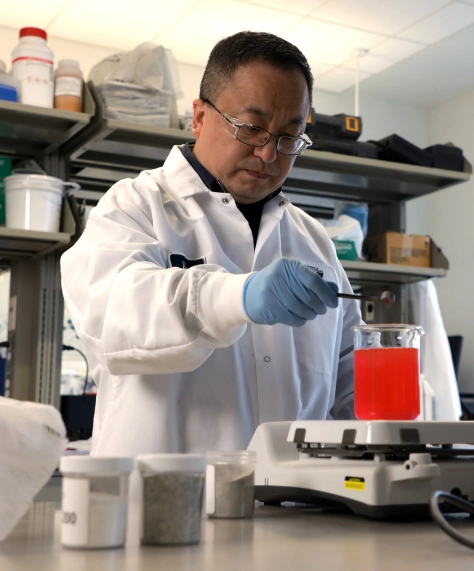UNIQUE MINERALS, ESSENTIAL TECHNOLOGIES.
Learn more about our differentiated global minerals.
Bentonite
Bentonite is known as the "mineral of a thousand uses." It is the common name for naturally occurring clay that contains the active montmorillonite mineral.
Bentonites are typically classified as either sodium (swelling) or calcium (non-swelling) based on their interlayer exchangeable cations and ability to swell in water.
Based on MTI's proven ability to selectively mine for specific applications and modify the surface of the mineral to deliver performance, bentonite clay has major commercial applications in foundry green sand binders, building waterproofing, cat litter, geosynthetic clay liners for environmental uses, iron ore pelletizing, drilling muds, edible oil clarification, animal feeds, and wine and juice clarification. Specialty applications of bentonite clay include asphalt emulsions, catalysts, cosmetics, paints and pharmaceuticals.
Precipitated Calcium Carbonate (PCC)
Precipitated Calcium Carbonate, commonly referred to as PCC, is also known as purified, refined, or synthetic calcium carbonate. Calcium carbonates including PCC are considered to be non-toxic and the U.S. Food and Drug Administration has affirmed them to be GRAS (Generally Recognized As Safe). As long as the PCC meets certain purity requirements, it can be used as a direct food additive, pharmaceutical, or indirect additive in paper products that come in contact with food. Similar acceptances and approvals exist around the world where PCCs are widely used in these applications. PCC is generally made from a high purity calcium carbonate rock called limestone.
Ground Calcium Carbonate (GCC)
Ground calcium carbonate, commonly referred to as GCC, is widely used as an industrial mineral. Three primary attributes -- particle size, color, and chemical purity -- define the quality of the GCC and the suitability of use for any given application.
GCC products range in size from ½” (1.7 cm) white decorative landscaping stones to fine 2-micron powders and are used in a wide range of applications, including for building products, paints, plastics, agriculture, glass, and others. Food-grade GCCs can be used for food and chewing gum.
Leonardite
Leonardite is an oxidation product of lignite coal and mined from near-surface pits.
The commercial applications of leonardite are driven by the utilization of the humic acid and fulvic acid constituents. Significant market applications of leonardite are in the oil well drilling industry, in agricultural applications as plant growth aid and soil conditioner, and as a clay dispersant in the metalcasting industry. Additional specialty applications include remediation of soil contamination and water treatment.
Magnesium Oxide
Magnesium hydroxide is obtained by the treatment of magnesium chloride solutions, typically seawater, with lime. Calcining at different temperatures produces magnesium oxide (MgO) of different reactivity.
Magnesium oxide can be used as an aggregate and matrix in a variety of products in the steelmaking industry as well as in the non-ferrous product, petrochemical, cement, and power generation industries. Its primary function is to provide thermal insulation and chemical stability.
Pyrolytic Graphite
Pyrolytic graphite (PG) is a specialized, "five-nine" purity, chemical vapor deposition (CVD) carbon product grown atom-by-atom with unique thermal, electrical, and chemical properties including superior EMI performance. These materials have applications where extreme temperatures up to 6000°F (3300°C) and corrosive environments exist, because they conduct heat across their (a-b) planar surface like copper and insulate like ceramics in the (c) thickness direction. In addition, PG has been determined to be highly diamagnetic, which means that it is conducive to the enhanced imaging process for medical applications.
With its unique thermal and electrical characteristics, PG is used by industries that require a lightweight material solution because they face problem applications resulting from excessively high temperature, stress, corrosion, and friction.
Lime
Lime, sometimes referred to as quicklime, is a term commonly applied to a number of related materials. Pure lime is calcium oxide (CaO) formed by “burning” a form of calcium carbonate such as limestone or marble (CaCO3). Dolomite, a calcium magnesium carbonate (CaMg(CO3)2) can also be calcined to form dolomitic lime, which has different reactivity due to the presence of MgO.
Hectorite
Hectorite is the common name for a relatively rare, naturally occurring clay as well as the name of the active mineral in the clay. Hectorite is a trioctahedral, magnesium-based smectite clay. The unique properties of the hectorite active mineral are very small platelet size, an elongated platelet structure with an inherent negative charge counterbalanced by exchangeable sodium (Na+) ions, light color with low iron content and high viscosifying ability in water.
Hectorite is used in applications that require lighter color, higher viscosity, and thermal stability. Commercial applications include ceramics, cosmetics, high temperature organoclays for oil well drilling, and paints and coatings.

Driven by Technology. Powered by Possibility.
We’re inspired problem-solvers. Our teams deliver deep expertise and dedicated partnership to help you sustainably achieve your goals today and unlock new opportunities for tomorrow.
Expertise
Sustainability